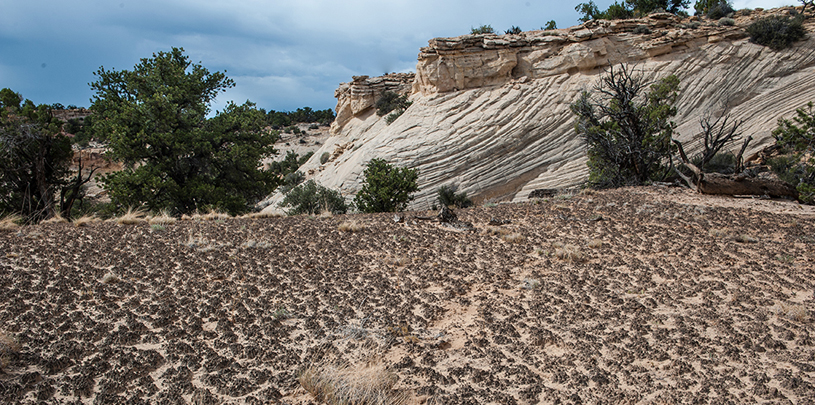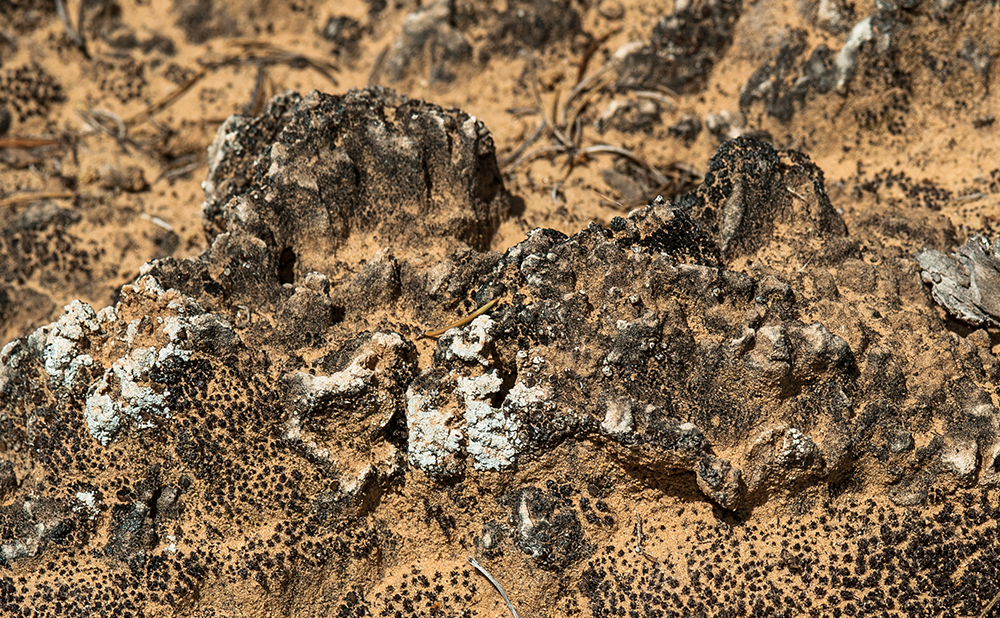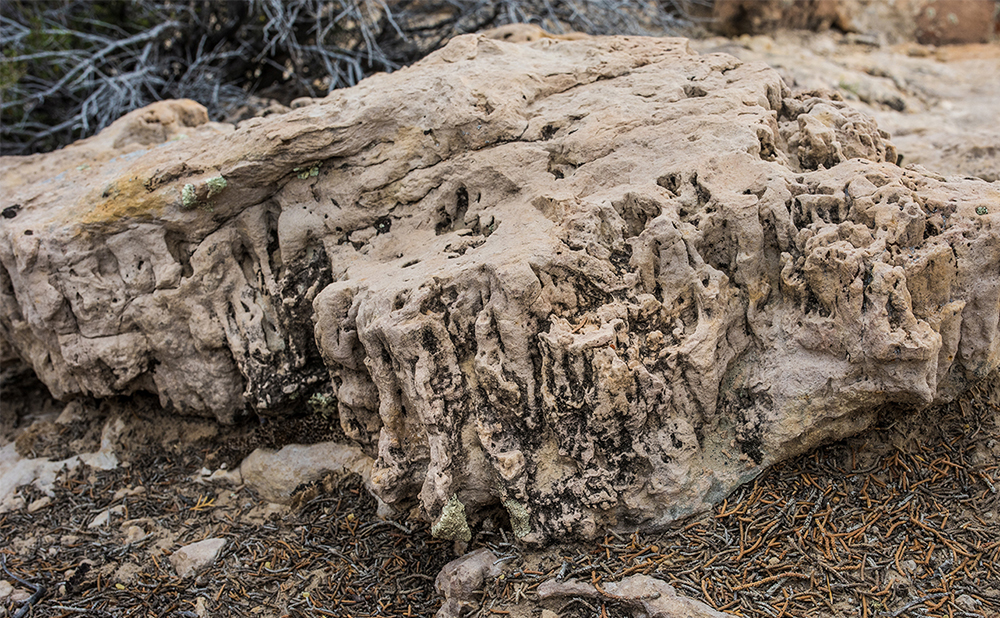
 Guest post by Ellen Morris Bishop, photographer, writer, and geologist
Guest post by Ellen Morris Bishop, photographer, writer, and geologist
As a geologist, I often travel through time. Show me a braided river channel, and I am standing on the banks of a Kaiparowits Plateau stream whose floods carried dinosaurs to their deaths 70 million years ago and left their carcasses as triumphant finds for today’s paleontologists.
My most ancient trips—back to the Precambrian, almost three billion years ago—occur amid the darkly-crinkled landscapes of biological crusts. On this time-travel odyssey, the sky is green, the sun a hazy dim vestige of itself. The crusts’ brittle mosaic is the only living cover on an otherwise barren land.
But now, the same landscape offers a shorter trip—back to the Cretaceous, the heyday of dinosaurs. For, amid the Grand Staircase-Escalante desert's living crusts, and virtually indistinguishable from them, lie fossils of crusts that date to 80 million years ago.
Biological crusts’ dark pinnacles mantle the Escalante’s most arid landscapes in southern Utah. Archaic and primordial, plants without leaves, the crusts’ foundational cyanobacteria (aka: blue-green algae) are barely plants at all. The lichen and mosses that roof crusts’ firm surface are comparatively more advanced (they have vascular systems) but still primitive by evolutionary standards. Mosses and lichens have been around since at least the Silurian—about 475 million years ago. The cyanobacteria that carpet the desert surface are far more ancient. We can trace them back to the Archean—at least 2.8 billion, and maybe to 3.5 billion years go.
Without cyanobacterial biological crusts, the rest of life as we know it might never have developed. Cyanobacteria invented photosynthesis and, about 2.5 billion years ago, began to pump oxygen into Earth’s primitive, oxygen-poor atmosphere. Geologists call this the “Great Oxygenation Event”. It began a new geological era, the Proterozoic—or earliest life. Of all events in Earth’s history, this is perhaps the most important. Cyanobacteria introduced oxygen into the atmosphere, and ultimately, oxygen-based, life became dominant. The most humble of organisms literally paved the way for us.

(Mature modern crust with moss and lichen, Grand Staircase-Escalante National Monument)
The fossil record of the most ancient biological crust—perhaps the first life on land—is challenging to find and interpret. The earliest evidence of terrestrial crusts, discovered by University of Oregon geologist Greg Retallack, occurs in the sandstones of Mt. Grant, Western Australia. This fossil record goes back to almost 3.5 billion years ago and includes wetland-based microbial mats similar to land-based crusts. Terrestrial ancient crusts have proved more elusive. Retallack has identified 1.5 billion-year-old fossil crusts in the Stirling Range Sandstone of Western Australia, and Thucomyces, a columnar biofilm crust in 2.8 billion-year-old fossil soils in South Africa. And there is no reason, he says, that crusts would not have covered the land surface as long ago as 2.8 billion years ago—and been a driving force in The Great Oxygenation Event.

(Fossilized Cretaceous crust has a similar structure to pinnacled crust today.)
You don’t have to go to Australia to witness the antiquity of biological crusts. There are fossil crusts right here, in the Grand Staircase-Escalante National Monument. They date to the heyday of dinosaurs, about 80 million years ago.
Geologist Ed Simpson of Kutztown University and his colleagues discovered them by chance when working on plant fossils in the Wahweap Formation, southeast of Grosvenor’s Arch and Kodachrome State Park. To find these rare exposures, I tracked down his GPS coordinates. A primitive road east of the arch followed by a walk along a geological contact between the Wahweap and Kaiparowits Formations led to a lonely sandstone ridgetop encompassed by dark, crinkled modern crusts.
The exposure is small, but it is striking. The 300 square feet of fossilized Cretaceous crust is different from any sandstone outcrop I have ever seen—it is stunning in its detailed preservation of crenulated crust. To anyone who knows biological crusts, it is unmistakable. The same pinnacles crinkle its surface as its neighboring, living crust. The fossil version is lighter in color. And yet, where 80-million-year-old crust is side-by-side with modern crust, it is difficult to discern where one ends and the other begins.
Simpson’s work, published in 2010, reveals that these Cretaceous crusts developed on small sand dunes along the banks of a braided stream. This landscape might have looked a bit like the floodplain along the upper San Juan River today. It was a warm time—temperatures similar or slightly higher than today’s. Simpson points out that the presence of crusts, braided nature of the streams, and the presence of sand dunes indicate an arid climate. The San Juan with dinosaurs.
In time, rainfall increased, and by 75 million years ago, much of the area was a vine-covered subtropical dinosaur paradise—preserved as the Kaiparowits Formation, world-renowned as a dinosaur treasure-trove. But it is a treasure-trove built on a foundation of crusts that preserved soils and paved the way for dinosaurs to rule here.
In arid lands, whether in the Archean, Cretaceous, or today, crusts truly are the stuff of life—the glue that holds the fragile, friable desert soil together, that keeps it from blowing away altogether, and that maintains its fertility. Pinnacled crusts capture water in their miniature valleys, provide a porous seal that keeps water under the surface and accessible to grasses, and fix nitrogen to nourish higher plants.
Trampling, whether by cattle, horses, or humans, easily destroys crust. Research by USGS scientist Jayne Belnap demonstrates that it takes more than a quarter-century for crust to fully re-establish once it is obliterated. And until it comes back, wind and water play havoc with fragile desert soils.
This highly functional yet humble and resilient life has thrived in the Grand Staircase-Escalante for at least 80 million years and likely much longer. Today, as climate changes, and even greater aridity takes hold, biological crust is increasingly important to retain scarce moisture and protect soils from erosion.
The next time you see those dark, pinnacled surfaces, take a moment to marvel at what is likely the oldest life-form on the planet. Take a short journey to the Archean, when crusts were the only life on land. Imagine yourself on the low, crust-covered dunes on an ancient stream, with the grunts of Triceratops and roars of T-rex in the background. And then fast forward to the future, when, in a warmer world, crust may once again be the strongest life force in the desert, holding soils in place for a time when the planet cools and abundant grass returns. Crusts have been here for a long time. We need them to be here even longer.
Ellen Morris Bishop has helped document the work of the Trust's Utah Forests' Program. She lives in Joseph, Oregon where she is working with Eastern Oregon Legacy Lands – a new natural-history-based educational center.
You have the opportunity to comment on how you think some of the most beautiful landscapes in Utah should be managed for the next generation to come.
Read MoreTree ring data helps scientists and land managers protect old-growth pinyon and juniper trees.
Read MorePack your camera and head for the trees! The Colorado Plateau has some of the best displays of fall foliage all season long.
Read More